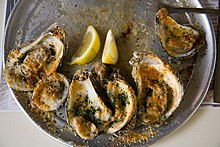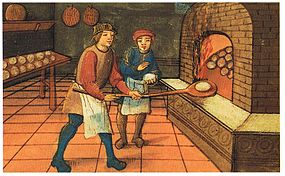How Many Is Two Dozen

A box of a dozen doughnuts
A dozen (commonly abbreviated doz or dz) is a grouping of twelve.
The dozen may be i of the primeval primitive integer groupings, perhaps because there are approximately a dozen cycles of the Moon, or months, in a cycle of the Dominicus, or yr. Twelve is convenient because it has a maximal number of divisors among the numbers up to its double, a property merely true of one, 2, 6, 12, 60, 360, and 2520.[1]
The use of twelve equally a base number, known as the duodecimal system (also as dozenal), originated in Mesopotamia (see as well sexagesimal). Counting in base-12 can hands be accomplished on one'south hands past counting each finger bone with one's thumb. Using this method, one mitt tin can count to twelve, and two easily (with the 2nd hand as a placeholder for representing units of twelve) can count to 144. Twelve dozen (122 = 144) are known as a gross; and twelve gross (123 = 1,728, the duodecimal 1,000) are called a corking gross, a term most often used when aircraft or buying items in bulk. A great hundred, likewise known as a small gross, is 120 or ten dozen.
A baker's dozen, also known as a large or long dozen, is a grouping of 13. Varying by country, some products are packaged or sold past the dozen, often foodstuff (a dozen eggs). Dozen may also be used to express a large quantity as in "several dozen" (e.g., dozens of people came to the political party).[ii]
Etymology [edit]
The English word dozen comes from the onetime form douzaine, a French word significant "a group of twelve" ("Aggregation de choses de même nature au nombre de douze" (translation: A grouping of twelve things of the aforementioned nature), as divers in the eighth edition of the Dictionnaire de 50'Académie française).[3] [4] [v] This French give-and-take[half dozen] is a derivation from the cardinal number douze ("twelve", from Latin duodĕcim) and the collective suffix -aine (from Latin -ēna), a suffix also used to form other words with like meanings such as quinzaine (a group of fifteen), vingtaine (a group of twenty), centaine (a group of one hundred), etc. These French words have synonymous cognates in Spanish: docena,[7] [8] [ix] quincena, veintena, centena, etc. English dozen, French douzaine, Catalan dotzena, Portuguese "dúzia", Persian dowjin "دوجین", Arabic durzen "درزن", Turkish "düzine", German Dutzend, Dutch dozijn, Italian dozzina and Polish tuzin, are as well used equally indefinite quantifiers to mean "about twelve" or "many" (as in "a dozen times", "dozens of people").
A confusion may ascend with the Anglo-Norman dizeyne (French dixaine or dizaine) a tithing, or group of ten households[ten] — dating from the earlier English language system of grouping households into tens and hundreds for the purposes of law, order and mutual surety (run across Tithing). In some texts this 'dizeyne' may be rendered as 'dozen'.[11] [ page needed ]
Half a dozen [edit]
The phrase one-half a dozen normally means six (6) of something.

Half dozen chargrilled oysters
Baker's dozen [edit]

The "baker's dozen" may accept originated as a way for bakers to avoid being blamed for shorting their customers.
A bakery's dozen, devil's dozen,[12] [13] long dozen, or long measure is 13, one more than than a standard dozen. The broadest use of baker'south dozen today is but a group of thirteen objects (oft baked appurtenances).[14] The term has meant different things over the last few centuries.
In the United Kingdom when selling certain goods, bakers were obliged to sell goods by the dozen at a specific weight or quality (or a specific boilerplate weight). During this fourth dimension, bakers who sold a dozen units that failed to meet this requirement could be penalized with a fine. Therefore, to avoid risking this penalty, some bakers included an actress unit of measurement to be sure the minimum weight was met, bringing the total to 13 units or what is now commonly known every bit a bakery's dozen.[15] [ better source needed ]
According to the Oxford English Dictionary, the term "baker's dozen" originated in the tardily 16th century and is "apparently so called after the former practice amidst bakers of including a thirteenth loaf when selling a dozen to a retailer, the extra loaf representing the retailer'south turn a profit."[16]
According to the 1811 Classical Dictionary of the Vulgar Tongue, by Francis Grose, "a Baker's Dozen is Thirteen; that number of rolls being allowed to the purchaser of a dozen".[17] However, reverse to virtually sources, according to the anonymous 1785 version of that lexicon, which was probably also by Grose, "a Baker's Dozen is Fourteen, that number of rolls being allowed to the purchaser of a dozen".[xviii]
The term has also been defined in a jocular mode, as "twelve of today's and one of yesterday's."[ citation needed ]
The 13th loaf added to the dozen is called the vantage loaf.[nineteen]
Texas dozen [edit]
A bottom used term is the Texas Dozen, which generally consists of 15. This is typically used merely in Texas and surrounding areas for such goods as flowers or baked goods, although tin be applied to anything that is counted, such as photographs. [20]
Run across as well [edit]
- Lagniappe
- Fourteener (poetry)
- Seed-counting auto
References [edit]
- ^ "A072938 - Oeis".
- ^ Longman Dictionary of Contemporary English, 2013, Procter, Paul 1408267667
- ^ Bartleby, archived from the original on December 10, 2006
- ^ "Dozen". Free Dictionary. Merriam-Webster. Retrieved 2011-10-28 .
- ^ "dozen". Oxford Dictionaries Online. Inquire Oxford. Archived from the original on September 26, 2007. Retrieved 2013-01-31 .
- ^ "Douzain, Douzaine, Douze, Douze-huit, Douzième, Douzièmement, Dox(o)-, Doxographe, Doxologie, Doyen". Patrimoine de France. Archived from the original on 2011-09-29. Retrieved 2011-ten-28 .
- ^ "docena". Diccionario Usual (in Spanish). Real Academia Española. Retrieved 2011-x-28 .
- ^ "doce". Diccionario Usual (in Spanish). Real Academia Española. Retrieved 2011-x-28 .
- ^ "‐ena". Diccionario Usual (in Castilian). Real Academia Española. Retrieved 2011-10-28 .
- ^ "pregnant #4", English Dictionary, Oxford .
- ^ Melville-Lee (1901), A History of Police force in England, Methuen
- ^ "devil'southward dozen", Merriam-Webster.com Dictionary
- ^ "devil – phrases: the devil's dozen". Concise Oxford English Dictionary: Luxury Edition. Vol. 12. Oxford University Press. 2011. p. 392. ISBN9780199601110.
- ^ Webster (1999), Webster'southward 2 New Higher Lexicon , Houghton Mifflin Visitor, ISBN0395962145 .
- ^ "The Baker's Dozen", The Baker's Helper, vol. 36, Clissold Publishing Company, 1921, p. 562 .
- ^ Stevenson, Angus (2010), Oxford English Dictionary (tertiary ed.), ISBN9780191727665 .
- ^ Francis Grose (2007) [1811], Classical Lexicon of the vulgar tongue (unabridged ed.), p. 18 .
- ^ Francis Grose (1785) [1785], A Classical Lexicon of the Vulgar tongue, p. 19 .
- ^ Brewer's Lexicon of Phrase and Fable. London: Cassel and Co. 2000. pp. 1227. ISBN0304350966.
- ^ "Texas Monthly". April 1980.
External links [edit]
- History of the term Baker's dozen The Phrase Finder
How Many Is Two Dozen,
Source: https://en.wikipedia.org/wiki/Dozen
Posted by: branchingents.blogspot.com


0 Response to "How Many Is Two Dozen"
Post a Comment